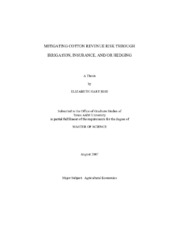| dc.description.abstract | Texas is the leading U.S. producer of cotton, and the U.S. is the largest international
market supplier of cotton. Risks and uncertainties plague Texas cotton producers with
unpredictable weather, insects, diseases, and price variability. Risk management studies
have examined the risk reducing capabilities of alternative management strategies, but
few have looked at the interaction of using several strategies in different combinations.
The research in this study focuses on managing risk faced by cotton farmers in Texas
using irrigation, put options, and yield insurance. The primary objective was to analyze
the interactions of irrigation, put options, and yield insurance as risk management
strategies on the economic viability of a 1,000 acre cotton farm in the Lower Rio Grande
Valley (LRGV) of Texas. The secondary objective was to determine the best
combination of these strategies for decision makers with alternative preferences for risk
aversion.
Stochastic values for yields and prices were used in simulating a whole-farm
financial statement for a 1000 acre furrow irrigated cotton farm in the LRGV with three
types of risk management strategies. Net returns were simulated using a multivariate empirical distribution for 16 risk management scenarios. The scenarios were ranked
across a range of risk aversion levels using stochastic efficiency with respect to a
function.
Analyses for risk averse decision makers showed that multiple irrigations are
preferred, and that yield insurance is strongly preferred at lower irrigation levels. The
benefits to purchasing put options increase with yields, so they are more beneficial when
higher yields are expected from applying more irrigation applications. | en |


